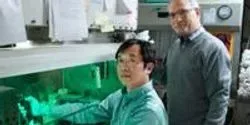Proteins

Open any introductory biology textbook and one of the first things you’ll learn is that our DNA spells out the instructions for making proteins, tiny machines that do much of the work in our body’s cells. Results from a study published on Jan. 2 in Science defy textbook science, showing for the first time that the building blocks of a protein, called amino acids, can be assembled without blueprints – DNA and an intermediate template called messenger RNA (mRNA). A team of researchers has observed a case in which another protein specifies which amino acids are added.

A research team led by physicists at the University of Wisconsin-Milwaukee (UWM) has proven a method that makes it possible to find the atomic structure of proteins in action by producing “snapshots” of them with unprecedented spatial and temporal resolution

By tracking down how bacterial defense systems work, the scientists can potentially fight infectious diseases and genetic disorders.

Caltech researchers have developed a novel way to visualize proteins generated by microorganisms in their natural environment—including the murky waters of Caltech's lily pond, as in this image created by Professor of Geobiology Victoria Orphan and her colleagues. The method could give scientists insights to how uncultured microbes (organisms that may not easily be grown in the lab) react and adapt to environmental stimuli over space and time.

Thermo Fisher Scientific has developed a high-resolution hydrophobic interaction chromatography (HIC) method that can separate a fusion protein from a truncated version and a structural isomer.












